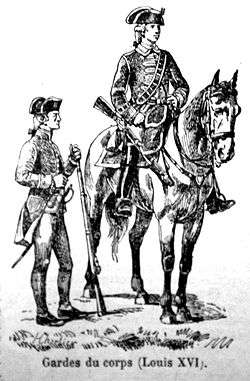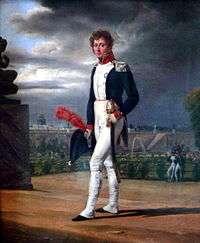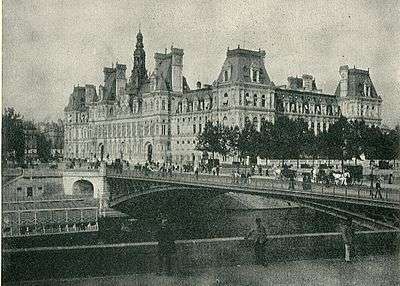Antoine Galiot Mandat de Grancey
Antoine Jean Galiot Mandat (7 May 1731, in the outskirts of Paris – 10 August 1792, on the steps of the Hôtel de Ville, Paris), known as the Marquis de Mandat, was a much-admired French nobleman, general and politician. A knight and lord of Berny-en-Santerre and Les Pins[1] in the Vendômois, he became a colonel in the Gardes-Françaises, then succeeded La Fayette as commander of the National Guard in 1792. He was assassinated by insurgents (possibly Jean Antoine Rossignol) in the events of the 10 August during the French Revolution.
Family
Heraldic arms
Azure, with a lion or; au chef d'argent, chargé d'une hure de sanglier de sable, défendue d'argent, accostée de deux roses de gueules.
History
The family had formerly been a noble family in the Limousin, attested since 1339.[2] Galiot Mandat, lord of Aigrefoin, was received as king's secretary for provisions on 31 October 1572 on the resignation of Louis Guybert and his father.[3] Its descendents were in two branches, of which the elder died out when Antoine-Galiot Mandat, conseiller to the parlement de Metz by letters dated May 1640, received as conseiller to the parlement de Paris on 14 July 1649, died unmarried and without issue. The other branch, known as the barons of Nully (in Champagne), has continued until our days and distinguish itself for many generations by its devotion to the monarchy.[4]
Antoine Galiot Mandat was the son of Galiot V Mandat (1683–1755), Maître des Requêtes ordinaire de l'Hôtel du Roi, received to the Grand Conseil on 6 March 1720. His mother, Marie Anne Cherouvrier des Grassières, was sister-in-law to marquis Louis-Urbain-Aubert de Tourny, Intendant of the Généralité de Limoges. The king confirmed his father in the land and seigneurie of Les Pins, in the north east of Touraine on 13 June 1727.
Life
Before 1789

He was baptised at Église Saint-Sulpice. He served in the First Company of Musketeers of the Garde ordinaire du Roi from 26 November 1753 to 2 March 1755, as enseigne à drapeau to the regiment of the Gardes-Françaises (1755–57), then as Enseigne à Pique (from 5 June 1757) and sous-lieutenant (23 December 1759) in the same regiment.
Antoine Galiot Mandat married Angélique Simone Boucher, daughter of a conseiller to the Parlement de Paris on 21 January 1758. They had two children – Alexandre, ensign to the regiment of the Gardes-Françaises, and a daughter married to a conseiller to the Parlement de Paris. Antoine's father split his fortune between his children on his death on 6 April 1762.
In 1789, he left the Gardes-Françaises, at the rank of captain[5] or colonel retiré du service, according to La Chenaye-Desbois.[6] He was also a knight of the ordre royal et militaire de Saint-Louis.[7] He tried in vain to become a gentleman of the court, but had to renounce his place despite his annual rent of 180,000 francs.[8]
In the pre-revolutionary period Marquis Antoine-Jean-Galiot de Mandat was loved by everyone in Les Pins, in the north east of Touraine, even by those who would soon lead Revolutionary efforts in the area. He is known in history as "a noble who embraced the revolutionary party"[9] and thus his behaviour corresponded to that of his neighbours and peasants.
After 1789

In 1789 Antoine Galliot Mandat was aged 58. He was head of the 4th Legion of the National Guard.[10] He lived at rue Chapon, n° 3. Brave and loyal to his oath to defend the inviolability of the head of state and the head of state's house,[11] he supported the new ideas but remained highly devoted to Louis XVI. He inspired great confidence in the royal court (in the words of Adolphe Thiers "to the cause by his energy and his lights". His remarks leave no doubt as to his fidelity to the king:
| “ | I know the fate in store for me, but I reply for the king's fate until my last breath. I shall never leave my post voluntarily | ” |
His ideas favouring a constitutional monarchy arose from those close to the king. Madame Campan, whose father was a friend of Mandat, answered Louis XVI's question "Who is this Mandat who at this moment commands the National Guard?" by saying "Sire, he is the most faithful of your subjects, but with much loyalty and very little intelligence. He is in the interests of the Constitution.".[12] The National Guard's attitude in 1792 was less loyal than Mandat's, though it varied from battalion to battalion:
| “ | One evening, on an excellent National Guard arriving at the Tuileries, the Queen went to the petit jardin du Dauphin, from which she returned via the terrasse de l’Eau. The federates passing along the quay, spotting the Queen, insulted her. Marie-Antoinette wanted to withdraw, but the National Guards begged her to do nothing and left them "to make these wits learn that we are not afraid of them". They thus cried "Long live the King and the royal family!". The federates complained about this at the Assembly the following day and the Assembly, although informed of their insolence, congratulated them. The national guards who accompanied the Queen were from the bataillon des Filles-Saint-Thomas. | ” |
Guy de Rambaud also wrote that "the bataillon des Filles-Saint-Thomas, bataillon des Petits-Pères, bataillon de Henri IV and bataillon des Grands Augustins, protected us from brigands and rebels".[13]
Antoine Galiot Mandat "always offered his head as a guarantee of the king's good intentions", but after the flight to Varennes and due to revolutionary propaganda he could no longer succeed in convincing all the national guards. The battalions of the Saint-Antoine and Saint-Marceau faubourgs were openly hostile to him from 1789 onwards and in the other battalions the poorest guards were favourable to Jacobin ideas.
Mandat replaces La Fayette

He replaced La Fayette shortly before 10 August 1792 as commander in chief of the National Guard. La Fayette had been impeached as a victim of false rumours as to his conduct and impeached. This proposition, backed by Brissot and heatedly fought by Vincent-Marie Viénot de Vaublanc and Quatremère de Quincy, was repulsed by a majority of 406 votes against 224.
Because of the vote, the deputies who had provoked him were assaulted, beaten and threatened with death after the session had ended, until the National Guard came to their rescue. According to Hippolyte Taine: As to de Vaublanc, the main defender of La Fayette, he was attacked three times, had taken the precaution not to go home but angry mobs showed up at his house, shouting that "four eighty people will perish at their hands, and he would be first." Twelve men who had climbed to into his apartment and rummaged around also ransacked nearby houses, and, unable to catch himself, looked for his family; they warned that if he returned to his home, he would be killed.[14] La Fayette tendered his resignation. The assault on the Tuileries was set for 10 August. The people of Marseille were given gunpowder and bullets by the municipality – a fact known to the court.
Mandat, whose side was outnumbered, intended to defend the courts by posting some Swiss and grenadiers. He even amassed the National Guard in the garden and placed cannons on Pont Neuf and St. John's Arcade, behind the Hôtel de Ville, to stop the rioters' descent from the suburbs.
Mandat's assassination


The results of Mandat's death

After his death
The sumptuous hôtel du Président Duret, 67 rue de Lille, belonged to him in 1792 and remained in his son's ownership until 1797 despite Galiot Mandat's assassination.
Notes and references
- ↑ Étrennes à la noblesse, contenant l'état actuel des maisons des princes souverains de l'Europe ..., p. 100
- ↑ Étrennes à la noblesse, contenant l'état actuel des maisons des princes souverains de l'Europe ... , p. 199
- ↑ Saint-Allais, t. III, p. 363.
- ↑ Annuaire de la noblesse de France et des maisons... , 1885, p. 355
- ↑ État de la France en 1789, by Paul Boiteau d'Ambly, p. 569
- ↑ Dictionnaire généalogique... 3e éd. Paris, 1863–1876, Page : 258 & 259, vol : 13
- ↑ Nobiliaire universel de France ou Recueil général des généalogies historiques des maisons ... – Page 367
- ↑ AN 03 361, doss. Mandat de Grancey & Mansel Philip, La cour sous la Révolution, p.151
- ↑ Dictionnaire biographique et historique des hommes marquants de la fin du dix-huitième siècle : et plus particulièrement de ceux qui ont figuré dans la Révolution française. 1800
- ↑ Almanach royal de 1792, p. 556
- ↑ Ternaux, Mortimer, Histoire de la Terreur 1792–1794, p. 217 & 218
- ↑ Ferrand, Jules (1817–1894), Histoire de la Révolution, p. 222n
- ↑ Guy de Rambaud, Pour l'amour du Dauphin, p. 103 et 104
- ↑ Taine, Les origines de la France contemporaine L'ancien régime, La révolution, L'anarchie, la conquête jacobine, page 691, de l'édition de 1986, Bouquin chez Robert Laffont ISBN 2-221-05186-6 (tome 1)